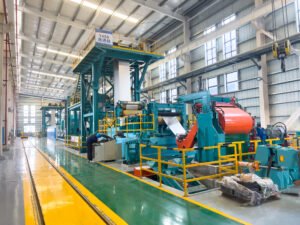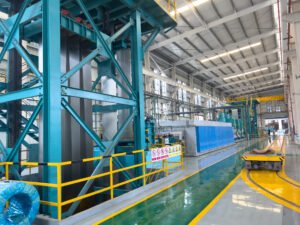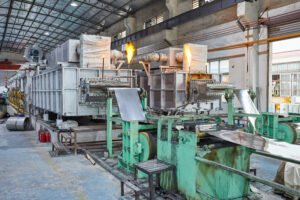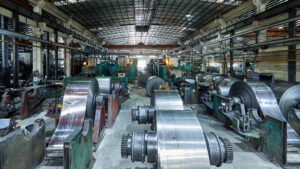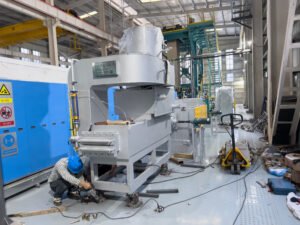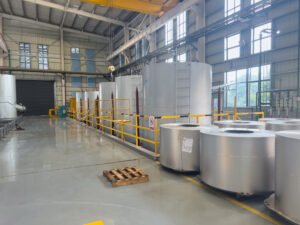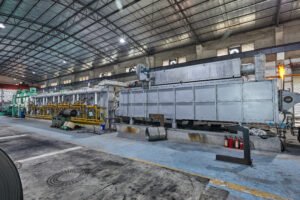How AKS Bright Annealing Furnace Achieves Mirror Finish on Stainless Strip

Striving for that perfect, flawless mirror finish on stainless steel strip can be frustrating. Imperfections, dullness, or oxidation can ruin product value and customer satisfaction. At AKS, we've engineered our Bright Annealing Furnaces1 to deliver consistently brilliant, defect-free surfaces, turning this challenge into a reliable outcome.
Achieving a mirror finish on stainless steel strip with an AKS Bright Annealing Furnace involves meticulous preparation of the strip, precise control over furnace temperature and protective atmosphere, uniform heating and soaking during annealing, followed by controlled cooling to prevent oxidation, and finally, rigorous inspection.
This pursuit of perfection isn't just about aesthetics; it's about delivering superior material properties and meeting the exacting standards of industries from automotive to high-end kitchenware. We understand that for our clients, a mirror finish is often a hallmark of quality. In this article, I'll walk you through the critical steps our furnaces employ to achieve this coveted result.
The journey to a mirror finish is a multi-stage process, where each step is as crucial as the last. From the initial preparation of the stainless steel strip to the final inspection, our bright annealing technology integrates advanced controls and design features. We've seen firsthand how slight deviations can impact the final surface. For instance, a client in the white goods sector, "Prestige Home Appliances," struggled with inconsistent sheen on their stainless steel panels. After integrating our bright annealing line, they reported a 98% acceptance rate for mirror-finished components. This isn't just about the furnace; it's about the science of heat treatment, material science, and process engineering2 working in concert. We'll delve into how optimizing each variable, from atmosphere purity to cooling rates, contributes to that flawless, reflective surface that distinguishes high-quality stainless steel products.
Step 1: Preparing Stainless Steel Strip for the Annealing Process
Entering the annealing process with a contaminated or improperly prepared stainless steel strip is a recipe for disaster. Oils, grease, dirt, or even residual drawing lubricants can vaporize and cause surface defects, preventing that sought-after mirror finish. Our pre-treatment considerations ensure your strip is pristine.
Preparing stainless steel strip for bright annealing involves thorough cleaning to remove oils, grease, dirt, and other surface contaminants. This typically includes degreasing, washing, and drying stages to ensure an immaculate surface ready for optimal heat treatment and a mirror finish.
The importance of a meticulously clean surface before bright annealing cannot be overstated. Any residue left on the stainless steel strip can lead to a host of problems within the furnace, including carburization, surface pitting, or discoloration3, all of which are detrimental to achieving a mirror finish. Think of it like preparing a canvas for a masterpiece; any blemish on the canvas will show through the paint. Similarly, any contaminant on the strip will manifest as a defect after annealing. We've worked with numerous clients, like "Precision Metal Coils" in Southeast Asia, who initially underestimated this step. They were processing stainless steel for high-end architectural applications where visual perfection was paramount. They experienced issues with patchy, inconsistent brightness. Upon reviewing their process, we identified that their pre-cleaning wasn't robust enough for the stringent requirements of a true mirror finish. Enhancing their degreasing and rinsing stages, based on our recommendations, dramatically improved their output. This initial phase is foundational; it sets the stage for the subsequent thermal processes to work their magic. Without it, even the most advanced furnace technology will struggle to deliver the flawless, reflective surface that defines a mirror finish. It's an investment in quality that pays dividends in reduced rework and superior product appeal.
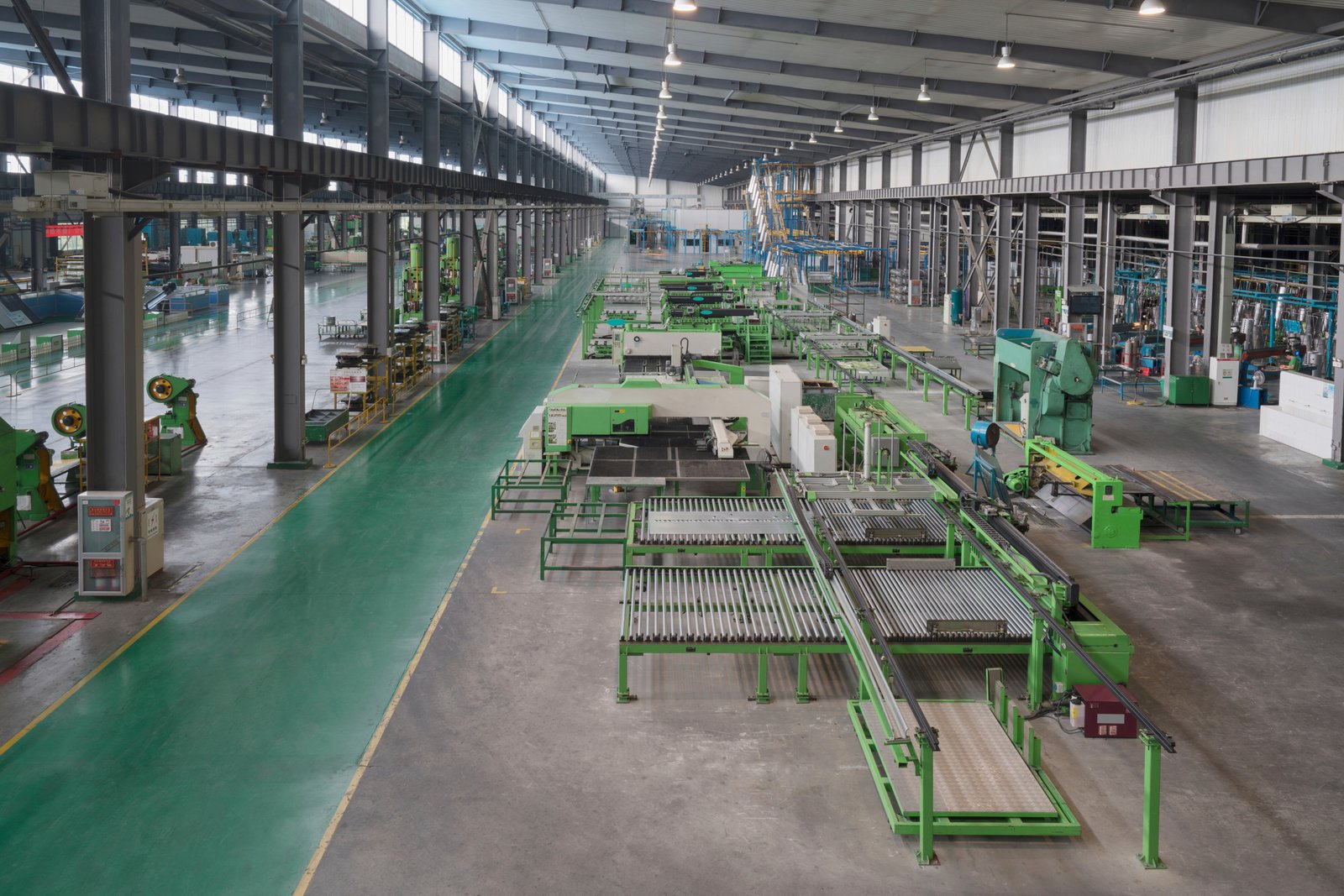
The journey to a flawless mirror finish begins long before the stainless steel strip enters the bright annealing furnace. The meticulous preparation of the strip surface is a non-negotiable prerequisite, forming the bedrock upon which subsequent annealing success is built. This stage is critical because the extreme temperatures and controlled atmospheres within the furnace can amplify any surface imperfections or contaminants, leading to undesirable outcomes.
The Critical Role of Surface Cleanliness
The primary objective of pre-treatment is to achieve a chemically clean surface, free from any organic or inorganic contaminants. Common culprits include rolling oils, drawing lubricants, shop dirt, metallic fines, and even fingerprints. If not removed, these substances can carbonize or react with the furnace atmosphere and the steel surface at elevated temperatures. For example, residual oils can lead to soot deposition or carburization, creating a dull, discolored, or even structurally altered surface. I recall a case with "AutoShine Parts," a manufacturer of stainless steel exhaust components. They were experiencing black smudges on their parts post-annealing. An audit revealed that their ultrasonic cleaning tanks for the stainless steel strips were not being replenished frequently enough, leading to a build-up of emulsified oils that redeposited on the strips. Upgrading their cleaning bath maintenance protocol and introducing a final solvent wipe for critical batches eliminated the issue, allowing our furnace to produce the bright, clean finish they required.
The cleaning process itself is often multi-stage. It typically starts with alkaline degreasing to saponify and emulsify oils and greases. This might be followed by a water rinse, then perhaps an acid pickling stage (though less common for bright annealing lines where the goal is to preserve the surface, pickling is more for scale removal before cold rolling), and certainly a thorough final rinsing with deionized water to prevent water spots. Drying is also crucial; residual moisture can introduce oxygen into the furnace entrance, compromising the protective atmosphere. We've seen facilities achieve surface cleanliness levels where contact angle measurements show near-perfect wettability, indicating an extremely low level of organic residue. For mirror finishes, the standard is exceptionally high. For instance, residual carbon on the surface should ideally be less than 0.2 mg/m².
Achieving this level of cleanliness consistently requires robust process control. This includes monitoring the concentration and temperature of cleaning solutions, managing rinse water quality, and ensuring a an effective drying process, often using hot air blowers. Some advanced lines even incorporate plasma cleaning or electrolytic cleaning for the most demanding applications, though for most bright annealing of standard stainless grades like 304 or 430, a well-maintained chemical cleaning line is sufficient. The key is understanding that any shortcut here will inevitably compromise the "mirror" aspect of the finish. One of our clients producing high-grade stainless steel strips for luxury watch casings insists on a multi-stage ultrasonic cleaning process using specialized, low-residue detergents, followed by an isopropyl alcohol rinse and forced hot air drying, all performed in a cleanroom-like environment before the strip enters the annealing line. This extreme care is what allows them to achieve a Ra (average roughness) value of less than 0.05 micrometers post-annealing.
Impact of Prior Mechanical Processing on Annealing Readiness
Beyond chemical cleanliness, the mechanical state of the surface inherited from prior processing steps like cold rolling significantly influences the final bright annealed finish. The cold rolling process itself imparts a certain surface texture and level of residual stress. While bright annealing relieves these stresses and recrystallizes the grain structure, it generally doesn't significantly alter the micro-topography of the surface in terms of removing deep scratches or roll marks. Therefore, the quality of the cold-rolled surface is paramount. If the strip has surface defects like scratches, roll imprints, or excessive roughness before annealing, the bright annealing process will make these defects more apparent by cleaning the surface and enhancing its reflectivity. It's a common misconception that annealing can "heal" all prior surface sins; it primarily cleans and brightens what's already there.
For a true mirror finish, the strip fed into the bright annealing furnace must already possess a very smooth, defect-free surface from the final cold rolling pass, often achieved using highly polished work rolls in the tandem or Sendzimir mill. One of our customers, "ReflectAlloy Strips," who specializes in stainless steel for decorative panels, invested heavily in upgrading their 20-high rolling mill rolls and implementing stringent roll maintenance schedules. They found that by reducing the surface roughness (Ra) of their as-rolled strip from an average of 0.3 µm to below 0.1 µm, the quality of the mirror finish from our bright annealing furnace improved dramatically, with reflectivity values increasing by over 15%. This underscores the synergy required between upstream processes and the annealing stage.
Furthermore, inconsistencies in strip thickness or shape (e.g., edge waves or center buckle) can lead to uneven heating or contact with transport rolls within the furnace, potentially causing subtle variations in the annealed finish. While our AKS furnaces are designed to handle typical commercial tolerances, exceptionally poor strip geometry can pose challenges. Therefore, good upstream process control in rolling and slitting operations is beneficial for ensuring optimal conditions within the annealing furnace. We always advise our clients to consider the entire production chain when aiming for high-end finishes.
Ensuring Uniformity and Consistency in Strip Preparation
Consistency in preparation is key to achieving uniform mirror finishes batch after batch, coil after coil. This means standardizing cleaning procedures, regularly monitoring and maintaining cleaning equipment and solutions, and implementing quality checks before the strip enters the annealing line. Automated dosing systems for cleaning chemicals, continuous filtration of cleaning baths, and sensors for monitoring parameters like pH, conductivity, and temperature of cleaning solutions are becoming increasingly common in facilities aiming for top-tier finishes.
For example, a large stainless steel service center we work with, "Global Bright Steels" in Europe, implemented a fully automated cleaning line preceding their AKS bright annealing furnace. This system includes sensors that monitor the oil load in the degreasing tanks. When the oil concentration reaches a pre-set limit, the system automatically diverts flow to a standby tank and alerts maintenance for bath regeneration or replacement. This proactive approach has virtually eliminated surface cleanliness as a variable in their annealing quality, leading to a significant reduction in rejection rates for their mirror-finish products, which are primarily exported to automotive trim manufacturers.
Below is a simplified table illustrating common contaminants and their potential impact if not removed before bright annealing:
| Contaminant Type | Examples | Potential Impact if Not Removed | Recommended Cleaning Action |
|---|---|---|---|
| Organic Residues | Rolling oils, lubricants, grease, fingerprints | Soot, carburization, dull spots, discoloration | Alkaline degreasing, solvent cleaning |
| Inorganic Particles | Metallic fines, dust, scale particles | Pitting, surface inclusions, scratches | High-pressure rinsing, filtration |
| Water-Soluble Salts | Chlorides, sulfates from previous steps | Staining, water spots, localized corrosion | Thorough deionized water rinsing |
| Oxides (light) | Pre-existing light tarnish | Uneven brightening, residual discoloration | Mild acid dip (if necessary), or reliant on furnace atmosphere to reduce |
This systematic approach to strip preparation, focusing on achieving and maintaining an impeccably clean and smooth surface, is the unsung hero of the bright annealing process. It allows the carefully controlled conditions within the AKS furnace to work optimally, transforming a well-prepared strip into a brilliantly finished product. It’s a testament to the idea that excellence in manufacturing is often the sum of many meticulously executed small steps.
Clean strip ensures mirror finishПравда
Thorough cleaning removes contaminants that could cause defects during annealing, making it essential for achieving a flawless mirror finish.
Annealing removes deep scratchesЛожь
Bright annealing enhances surface reflectivity but cannot eliminate deep scratches or roll marks from prior processing steps.
Step 2: Setting Optimal Temperature and Atmosphere Conditions
Once the strip is perfectly clean, creating the ideal furnace environment is paramount. Incorrect temperature or a compromised atmosphere can lead to oxidation, scaling4, or an uneven finish, undoing all prior preparation. Our furnaces offer precise control to prevent these issues.
Optimal conditions for bright annealing stainless steel involve precise temperature control, typically between 1050°C to 1150°C (1922°F to 2102°F) depending on the grade, and a highly reducing protective atmosphere, commonly pure dry hydrogen or a hydrogen-nitrogen mix5, with a very low dew point 6.
Achieving the perfect mirror finish hinges critically on the meticulous control of both temperature and atmosphere within the bright annealing furnace. These two parameters are inextricably linked and must be managed with extreme precision. Think of it as conducting a delicate scientific experiment; even minor deviations can significantly alter the outcome. The temperature must be high enough to facilitate recrystallization and stress relief, yet not so high as to cause excessive grain growth which can be detrimental to mechanical properties and sometimes surface appearance. Simultaneously, the atmosphere must be exceptionally pure and reducing to prevent any oxidation or reaction with the stainless steel surface. I remember working with \"IndoSteel Brights,\" a major producer of stainless steel strips for kitchenware in India. They were initially using a dissociated ammonia atmosphere but struggled with consistent brightness and occasional nitriding issues on certain grades. After upgrading to one of our AKS furnaces with a precision hydrogen-nitrogen mixing and purification system, they saw a marked improvement. Their reject rates for surface imperfections dropped by nearly 12%, and the consistency of the mirror finish across different coils was significantly enhanced. This highlights how crucial the furnace's capability to maintain these optimal conditions is, especially for high-volume, quality-critical production. This stage is where the \"bright\" in bright annealing truly comes to life.
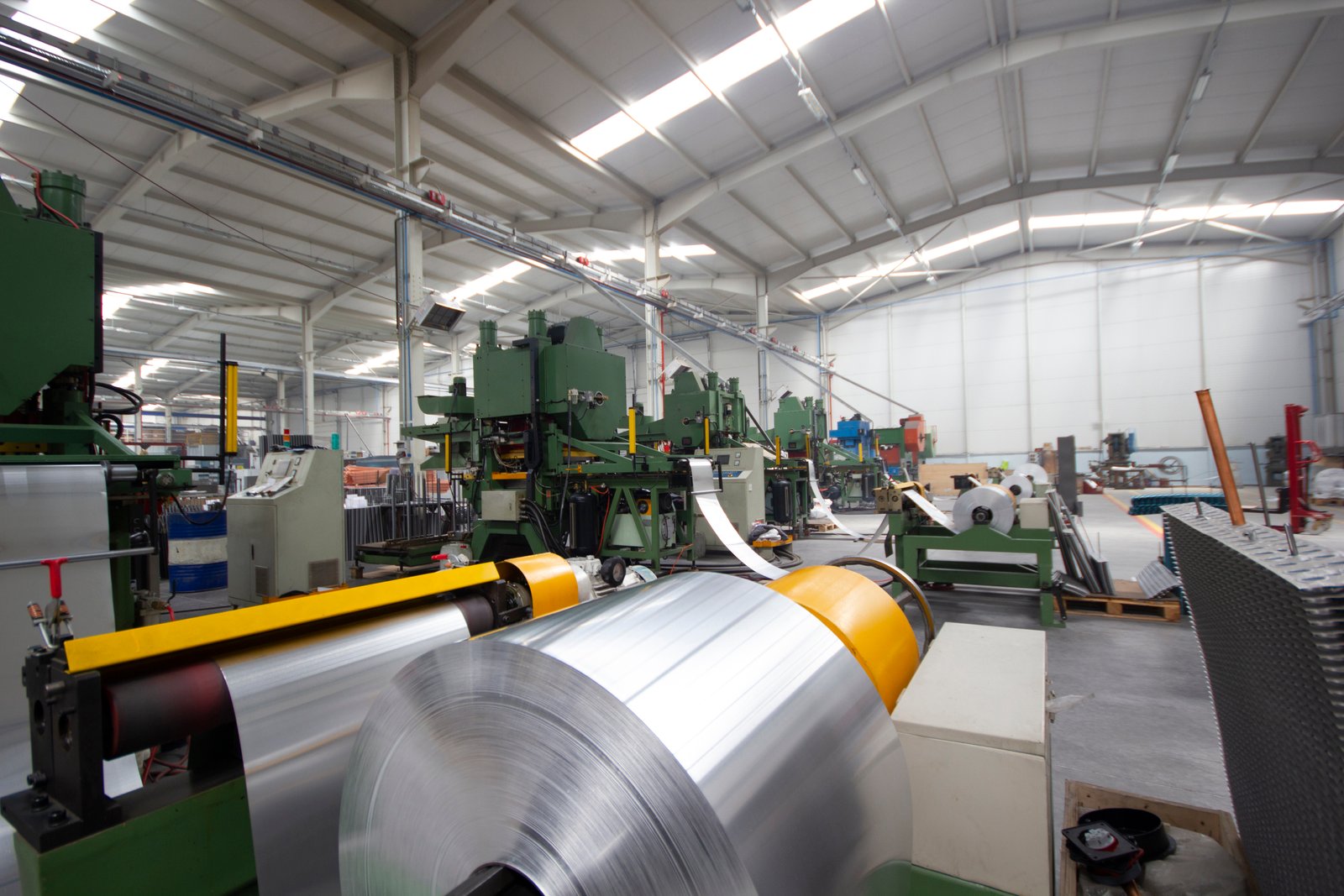
The heart of the bright annealing process lies in the precise establishment and maintenance of optimal temperature and atmosphere conditions within the furnace. These elements are not just settings; they are dynamic variables that must be controlled with a sophisticated understanding of metallurgy, thermodynamics, and gas dynamics to achieve the desired mirror finish and material properties.
Precision Temperature Control and Uniformity
The annealing temperature for stainless steel is critical. It needs to be sufficiently high to induce recrystallization of the cold-worked grain structure, relieve internal stresses, and dissolve carbides (for certain grades like austenitic stainless steels). For common grades like AISI 304 or 316, this temperature typically ranges from 1050°C to 1150°C (1922°F to 2102°F). For ferritic grades like AISI 430, the temperature might be slightly lower, around 800°C to 900°C. Our AKS furnaces utilize multiple heating zones, each equipped with high-precision PID (Proportional-Integral-Derivative) controllers and durable heating elements (e.g., Kanthal APM or Silicon Carbide, depending on the maximum temperature and atmosphere). This multi-zone control is vital for ensuring temperature uniformity across the width of the strip and along the length of the heating chamber. We aim for a temperature uniformity of ±5°C or better within the critical soaking zones. Uneven heating can lead to inconsistent grain size, varied mechanical properties, and even subtle differences in surface reflectivity, which would compromise a true mirror finish.
I recall a client, \"AeroGrade Metals,\" supplying thin stainless steel strips for aerospace components. They had extremely tight specifications for both mechanical properties and surface brightness. Their previous furnace exhibited temperature gradients across the strip width, leading to variations in tensile strength and a slightly \"cloudy\" appearance on one edge. After installing an AKS furnace with advanced zone control and carefully profiled heating element placement, they were able to achieve remarkable uniformity. Data from their inline pyrometers showed less than a 3°C variation across the strip width at the exit of the heating zone, directly correlating to consistent Rockwell hardness readings and a perfect, even mirror shine. This level of precision is achieved not just by the controllers, but also by the furnace design itself – the insulation quality, muffle material (often high-alloy nickel-chromium steels like Inconel or similar heat-resistant alloys), and internal flow dynamics play a crucial role.
The heating ramp-up rate is also a factor, particularly for thicker strips or sensitive alloys, to avoid thermal shock or uneven core-to-surface temperatures. Our control systems allow for programmable heating profiles, ensuring the strip reaches the soak temperature optimally. Data logging of temperature profiles is a standard feature, providing traceability and allowing for process optimization. For instance, analyzing temperature logs might reveal that a slightly slower ramp for a specific thicker gauge strip (e.g., 2mm 316L) results in better overall brightness due to more uniform heat penetration before entering the peak soak zone.
The Science of Protective Atmospheres
The protective atmosphere is the guardian of the stainless steel's surface during high-temperature annealing. Its primary role is to prevent oxidation and decarburization, and in some cases, to actively reduce any light surface oxides that may be present. For stainless steels, which contain chromium for corrosion resistance, preventing chromium oxidation is paramount. Chromium oxides are tenacious and difficult to remove, and their formation would completely negate the \"bright\" aspect of the annealing. The most common protective atmospheres used in our AKS Bright Annealing Furnaces are pure dry hydrogen (H2) or a mixture of hydrogen and nitrogen (N2), often referred to as forming gas.
Pure dry hydrogen is the most effective reducing agent and provides the brightest finish. Its strong reducing potential (low oxygen partial pressure) ensures that even trace amounts of oxygen or water vapor are scavenged. However, hydrogen is flammable and requires careful handling and safety systems, which are integral to our furnace designs. A hydrogen-nitrogen mix (e.g., 5-75% H2 in N2) is often used as a safer, more economical alternative, especially for less critical applications or certain stainless steel grades. While still reducing, its potential is lower than pure hydrogen. The key to any protective atmosphere is its purity, specifically its dryness, quantified by the dew point. A low dew point (typically -40°C to -60°C or lower) indicates very low moisture content. Moisture (H2O) at high temperatures acts as an oxidizing agent. Our furnaces often incorporate gas purification systems or utilize high-purity bottled gases with inline monitoring using dew point sensors and oxygen analyzers. For instance, maintaining an oxygen level below 5 ppm and a dew point below -50°C is common for achieving high-quality bright finishes on austenitic stainless steels.
\"FineWire Industries,\" producing fine stainless steel wires for medical applications, requires an absolutely pristine, oxide-free surface. They utilize an AKS furnace operating with 100% pure, dry hydrogen, with an inline molecular sieve purifier ensuring a dew point consistently below -65°C. This ultra-pure atmosphere is critical for their application, as even microscopic oxidation could compromise the biocompatibility or performance of the wire. The choice of atmosphere also depends on the specific stainless steel grade. For instance, high-carbon martensitic stainless steels might be prone to decarburization in very dry hydrogen, so atmosphere composition and dew point might be adjusted slightly.
Balancing Cost, Safety, and Performance in Atmosphere Selection
The selection of the protective atmosphere involves a careful balance of desired surface finish quality, operational cost, safety considerations, and the specific metallurgical requirements of the stainless steel being processed. While 100% hydrogen offers the highest reducing potential and thus the best chance for a superior mirror finish, it also comes with higher operational costs (gas consumption, purification) and more stringent safety infrastructure requirements.
Nitrogen-hydrogen mixtures (forming gas) offer a compromise. Nitrogen is relatively inexpensive and inert, while the hydrogen component provides the necessary reducing action. The percentage of hydrogen in the mixture can be tailored: lower percentages (e.g., 5-10% H2) are less flammable and reduce costs but offer less reducing power, suitable for less demanding applications or certain ferritic grades. Higher percentages (e.g., 25-75% H2) provide better brightening but increase costs and flammability concerns. Our engineers at AKS work closely with clients to determine the optimal atmosphere. For example, \"DecoTrim Ltd.,\" a UK-based company making decorative stainless steel profiles, switched from a 10% H2/N2 mix to a 25% H2/N2 mix in their AKS furnace. While gas costs increased marginally, the improvement in brightness consistency and reduction in rework for their mirror-finish 430 grade strips led to a net positive return on investment. They also found that the higher hydrogen content provided a slightly wider processing window for variations in incoming strip cleanliness.
The table below outlines some common atmosphere choices and their characteristics:
| Тип атмосферы | Состав | Dew Point Target | Reducing Potential | Cost | Safety Concerns | Typical Application |
|---|---|---|---|---|---|---|
| Pure Hydrogen | 100% H2 | < -60°C (-76°F) | Очень высокий | Высокий | Высокий | Austenitic SS, highest quality mirror finish |
| Hydrogen-Nitrogen Mix (High H2) | 25-75% H2, balance N2 | < -50°C (-58°F) | Высокий | Средний | Средний | Austenitic/Ferritic SS, good quality bright finish |
| Hydrogen-Nitrogen Mix (Low H2) | 5-10% H2, balance N2 | < -40°C (-40°F) | Moderate | Низкий | Низкий | Less critical brightness, some ferritic SS |
| Dissociated Ammonia (DA) | ~75% H2, 25% N2 (cracked NH3) | Variable, needs drying | High if dry | Low-Medium | Средний | General bright annealing, risk of nitriding |
Note: AKS generally recommends pure H2 or H2/N2 mixtures over DA for critical bright annealing due to better purity control and avoidance of potential nitriding from uncracked ammonia.
Ultimately, the precise settings for temperature and atmosphere are fine-tuned based on the specific grade of stainless steel, its thickness, the desired mechanical properties, and the ultimate surface finish requirements. Our furnace control systems provide the platform for this fine-tuning, enabling operators to save recipes for different products, ensuring repeatability and consistent quality. The interplay between a uniformly heated strip and a meticulously controlled, highly reducing atmosphere is what transforms a mundane metal surface into a brilliant, reflective mirror.
Hydrogen prevents oxidationПравда
Pure dry hydrogen acts as a strong reducing agent, scavenging oxygen and moisture to prevent chromium oxidation on stainless steel surfaces during bright annealing.
Higher temperature improves finishЛожь
Excessive temperature causes grain growth that degrades both mechanical properties and surface appearance. Optimal temperature ranges are grade-specific (1050-1150°C for austenitic).
Step 3: Executing the Annealing Process for Surface Perfection
Even with perfect preparation and optimal settings, the execution of the annealing soak itself is critical. Insufficient or excessive soak time, or instability in conditions, can lead to incomplete annealing or undesirable grain growth. Our furnaces ensure a controlled, stable soak.
Executing the annealing process involves passing the prepared stainless steel strip through the precisely heated furnace zones under a controlled protective atmosphere7. The strip is held at the target annealing temperature for a specific duration (soak time) to ensure complete recrystallization and stress relief for surface perfection.
Once the stainless steel strip, pristine from its preparation, enters the carefully calibrated environment of the AKS Bright Annealing Furnace, the core thermal transformation begins. This execution phase, the actual "soaking" at annealing temperature, is where the material's microstructure is refined to achieve both the desired mechanical properties and the flawless surface. It's a dynamic period; the strip is continuously moving, yet every segment must experience the exact same thermal history. Imagine a perfectly choreographed ballet, where every dancer (each segment of the strip) performs identical movements in precise synchronization. Any misstep (temperature fluctuation, atmosphere disturbance, speed variation) during this performance can mar the final outcome. We had a client, "Precision Springs Inc.," producing high-tensile stainless steel springs that also required a bright finish. They needed extremely consistent spring-back properties, which are directly tied to uniform annealing. Their challenge was ensuring that every millimeter of the rapidly moving thin strip received the exact soak time and temperature. Our furnace's advanced drive system, coupled with responsive temperature control, provided the stability they needed, reducing variations in spring constant by over 8% and simultaneously delivering the bright finish their customers expected. This phase is not just about heating; it's about controlled, uniform transformation under vigilant protection.
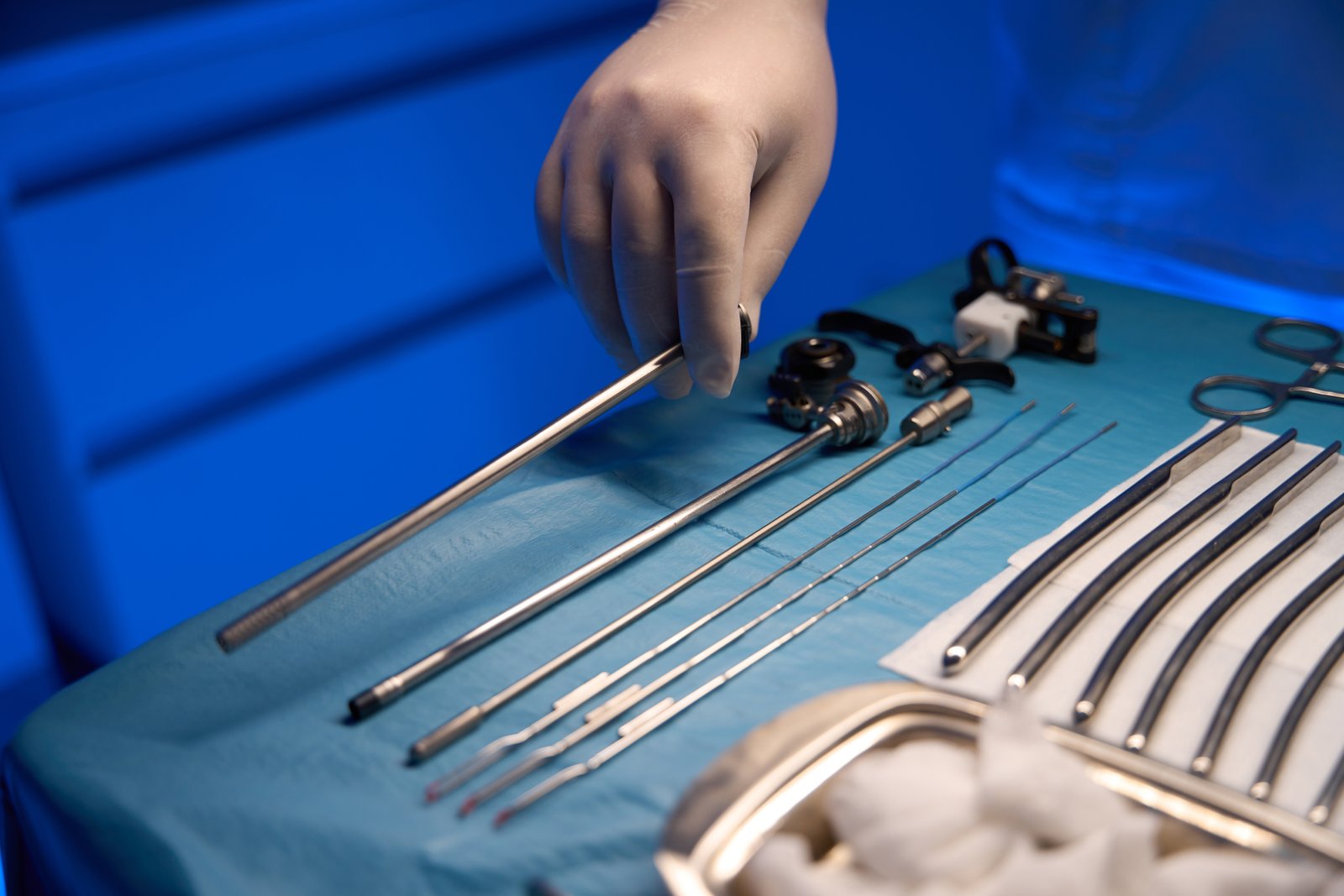
The execution of the annealing process within the furnace is the pivotal stage where the stainless steel strip undergoes its metallurgical transformation to achieve the desired properties and the coveted mirror finish. This involves careful control over the strip's transit through various furnace zones, ensuring uniform heating, adequate soaking at the target temperature, and maintaining the integrity of the protective atmosphere throughout.
Uniform Heat Transfer and Controlled Soak Time
As the stainless steel strip travels through the heating chamber of our AKS furnace, achieving uniform heat transfer to the entire mass of the strip – both across its width and through its thickness – is essential. Our furnaces employ strategically placed heating elements and often incorporate a muffle (a sealed inner chamber typically made of heat-resistant alloys like Inconel or similar Ni-Cr alloys) through which the strip passes. The muffle helps to distribute heat evenly and protect the strip from direct radiation from the heating elements, promoting more uniform heating. It also plays a crucial role in maintaining the purity of the protective atmosphere immediately surrounding the strip. For wider strips, the design of the heating elements and their zoning becomes even more critical to counteract edge heat losses and ensure a flat temperature profile across the strip.
The soak time, or the duration for which the strip is held at the peak annealing temperature, is another critical parameter. This is determined by the strip speed and the length of the effective heating (soak) zone. Soak time must be sufficient for complete recrystallization of the cold-worked structure and for stress relief. For austenitic stainless steels, it also allows for the dissolution of chromium carbides, which is important for corrosion resistance. However, excessive soak times or temperatures can lead to undesirable grain growth8, which can impair mechanical properties like formability and toughness, and in some extreme cases, can even affect the surface appearance (e.g., an "orange peel" effect after forming if grains are too large). Our PLC-based control systems precisely regulate strip speed, allowing operators to fine-tune the soak time based on the strip thickness, grade, and specific requirements. For example, a 0.5mm thick AISI 304 strip might require a soak time of 60-90 seconds at 1080°C, while a 2.0mm thick strip of the same grade would need a proportionally longer soak time (achieved by reducing line speed) to ensure the core reaches the target temperature and is adequately soaked. We've seen customers like "StripMasters Ltd.," who process a wide variety of gauges, benefit significantly from our recipe management system, which stores optimal speed and temperature profiles for each product, ensuring consistent results. They reported a 50% reduction in setup time when changing gauges, while maintaining excellent finish quality.
The design of the furnace entry and exit seals is also paramount during execution. These seals prevent the ingress of ambient air into the furnace and the loss of protective atmosphere. We utilize advanced sealing systems, often employing fiber curtains, labyrinth seals, or even dynamic nitrogen-flushed seals, especially at the hot exit where the strip is more reactive. Maintaining atmosphere integrity throughout the heating and soaking zones is non-negotiable for a bright finish. Any oxygen ingress would immediately lead to oxidation.
Managing Strip Tension and Transport
Maintaining consistent and appropriate strip tension throughout the annealing line is crucial, particularly for thin gauge materials. Excessive tension can cause stretching, necking, or even strip breakage, especially when the steel is hot and its yield strength is reduced. Insufficient tension can lead to strip wandering, buckling, or scratching if it contacts furnace components. Our AKS annealing lines incorporate sophisticated drive systems with load cells and dancer rolls9 to provide precise tension control. These systems automatically adjust motor speeds at the entry and exit bridles or payoff/recoiler units to maintain the pre-set tension values.
I recall a specific challenge with a client, "UltraThin Foils," who anneals stainless steel foils as thin as 0.05mm for specialized electronic applications. Maintaining stable transport and tension for such delicate material at high temperatures was a major hurdle. We engineered a specialized transport system for their AKS furnace, incorporating multiple, low-inertia driven rolls within the furnace muffle, along with highly sensitive dancer roll feedback. This ensured minimal stress on the foil, preventing deformation and maintaining its delicate, mirror-like surface. They were able to increase their line speed by 15% for these ultra-thin gauges without compromising quality, a significant productivity gain.
The support system for the strip within the furnace (if not a full catenary design) also matters. For horizontal furnaces, hearth rolls or walking beams are used. These components must be made of materials that do not react with the strip or the atmosphere at high temperatures, and their design must minimize contact points and prevent scratching. Ceramic rolls or specially coated alloy rolls are often employed. In our vertical bright annealing furnaces, which are excellent for preventing scratches on sensitive surfaces, the strip hangs freely, eliminating mechanical contact within the hottest zones. This design is particularly favored for achieving the absolute best mirror finishes on grades like 430 or 304 intended for reflective applications.
Real-time Monitoring and Process Adjustments
Modern bright annealing is not a "set and forget" process, especially when aiming for the highest quality mirror finishes. Real-time monitoring of key parameters allows for immediate adjustments and ensures process stability. Our AKS furnaces are equipped with sensors for continuous monitoring of:
- Temperature: Multiple thermocouples in each zone, plus optional strip pyrometers.
- Atmosphere: Oxygen analyzers, dew point sensors, hydrogen concentration monitors (if applicable), and flow rate meters for all gases.
- Strip Speed and Tension: Encoders, load cells, and dancer position sensors.
- Furnace Pressure: To ensure a slight positive pressure, preventing air ingress.
This data is fed into the central PLC system, which not only controls the process but also logs data for quality assurance and troubleshooting. For instance, if an oxygen sensor at the furnace exit detects a slight increase in O2 levels (perhaps indicating a seal wear issue), an alarm can be triggered, and in some automated systems, the nitrogen purge flow at the seals might be temporarily increased to counteract the ingress while alerting maintenance.
A client producing stainless steel for surgical instruments, "MediSteel Supplies," relies heavily on this real-time data. Their quality standards are incredibly stringent. The logged data from their AKS furnace – showing consistent sub-5ppm oxygen levels and dew points below -55°C throughout critical production runs – forms an integral part of their batch certification, giving their customers immense confidence in the material's surface integrity and cleanliness. This proactive, data-driven approach to executing the annealing process is what separates consistent, high-quality production from operations that frequently battle defects and inconsistencies.
Below is a conceptual representation of parameters controlled during annealing execution for a typical austenitic stainless steel strip:
| Параметр | Typical Target Range (AISI 304) | Control Method | Impact of Deviation |
|---|---|---|---|
| Soak Temperature | 1050 - 1120 °C (1922 - 2048 °F) | Multi-zone PID controllers, thermocouples | Too low: incomplete anneal; Too high: grain growth |
| Время выдержки | 45 - 120 seconds (gauge dependent) | Strip speed control (VFD drives) | Too short: incomplete anneal; Too long: grain growth |
| Atmosphere Purity (H2) | O2 < 5 ppm, Dew Point < -60°C | Gas purification, sealed muffle, precise flow control | High O2/Dew Point: Oxidation, loss of brightness |
| Strip Tension | 0.5 - 2.0 kg/mm² (gauge dependent) | Dancer rolls, load cells, coordinated drives | Too high: stretching; Too low: wandering, scratches |
| Furnace Pressure | +20 to +100 Pa (relative to ambient) | Gas flow balance, exhaust damper control | Negative pressure: Air ingress, oxidation |
By precisely managing these interconnected variables during the strip's journey through the furnace, we ensure that the metallurgical transformations occur uniformly and under ideal conditions, paving the way for that perfect, defect-free mirror surface.
Soak time affects grain structureПравда
Proper soak time allows complete recrystallization while preventing excessive grain growth that can impair mechanical properties.
Higher temperature always improves annealingЛожь
Excessive temperatures can cause undesirable grain growth and surface defects like orange peel effect.
Step 4: Cooling Down the Strip Without Oxidation
Emerging from the intense heat of annealing, the stainless steel strip is highly susceptible to oxidation if exposed to air. A poorly controlled cooling phase can instantly tarnish a beautifully annealed surface. Our furnaces feature specialized cooling sections to prevent this.
Cooling down the stainless strip without oxidation is achieved by passing it through an extended, sealed cooling section attached to the furnace. This section is continuously purged with the same protective atmosphere (e.g., dry hydrogen or hydrogen-nitrogen mix) until the strip temperature drops below its oxidation threshold (typically below 150-200°C)10.
The journey to a mirror finish doesn't end when the stainless steel strip leaves the heating zone. In fact, the cooling phase is equally critical. At elevated temperatures, even after exiting the main heating chamber, stainless steel remains highly reactive with oxygen. Exposing a hot, bright-annealed strip to air would instantly cause a layer of oxide to form, destroying the mirror finish and rendering all previous efforts futile. It's like carefully baking a perfect cake and then dropping it while taking it out of the oven. I recall a conversation with \"BrightCoil Industries,\" a processor of stainless steel for automotive trim. They were experiencing light, intermittent straw-colored discoloration near the coil edges. An investigation revealed that their older furnace's cooling section had minor leaks near the exit, allowing trace amounts of air to be drawn in when pressure fluctuations occurred. After refurbishing their cooling section seals and optimizing the protective gas flow based on our recommendations for their new AKS line, the problem vanished. This highlights the absolute necessity of maintaining atmospheric integrity not just during heating, but throughout the entire cooling process, until the strip is safely below its oxidation temperature.
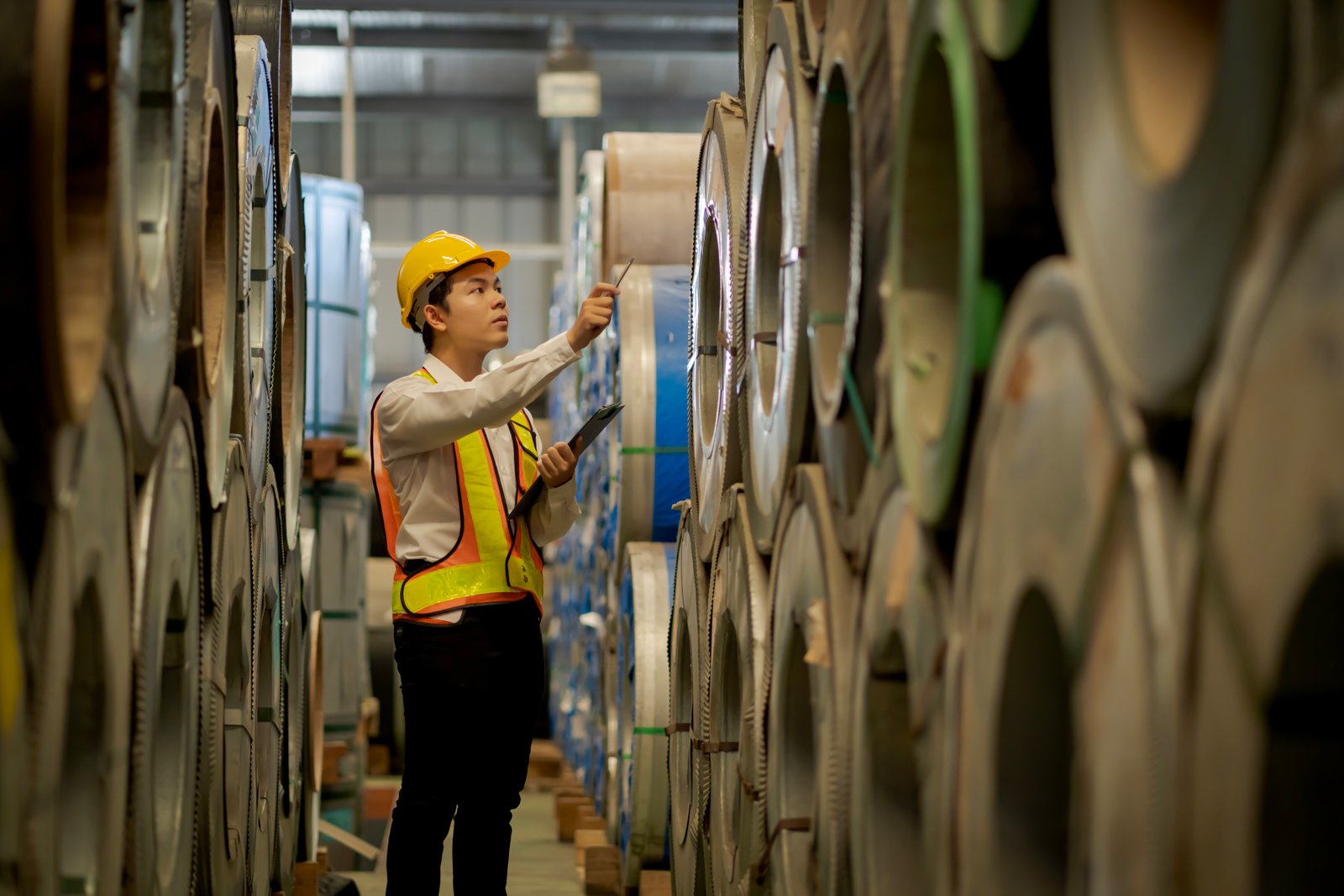
The cooling stage in bright annealing is a meticulously engineered process designed to bring the hot stainless steel strip from its annealing temperature down to a safe handling temperature without compromising the bright, oxide-free surface achieved in the heating zones. This requires maintaining the protective atmosphere throughout the cooling length and controlling the cooling rate.
Principles of Controlled Atmosphere Cooling
The fundamental principle behind bright cooling is to keep the stainless steel strip enveloped in the same high-purity protective atmosphere (pure dry hydrogen or a hydrogen-nitrogen mixture) that was used in the heating section. This protective envelope must be maintained until the strip's surface temperature drops well below the point where significant oxidation can occur in air. For stainless steels, this \"safe\" temperature is generally considered to be below 150-200°C (300-390°F), although for the most critical mirror finishes, cooling down to even lower temperatures (e.g., below 100°C) under protective gas is preferred before any exposure to ambient air.
Our AKS Bright Annealing Furnaces feature extended, insulated, and gas-tight cooling sections directly coupled to the heating chamber. These sections are continuously purged with the protective atmosphere, maintaining a slight positive pressure to prevent air ingress. The length of the cooling section is critical and is calculated based on the maximum line speed, strip thickness, and desired exit temperature. Effective cooling is typically achieved through a combination of methods:
- Radiant Cooling: In the initial part of the cooling section, the strip loses heat by radiation to the water-cooled or air-cooled walls of the cooling muffle or chamber.
- Convective Cooling (Jet Cooling): Further down the cooling section, high-velocity jets of the cooled, recirculated protective atmosphere are impinged onto both sides of the strip. This dramatically increases the heat transfer coefficient, leading to rapid and uniform cooling. The protective gas is drawn from the cooling chamber, passed through a heat exchanger (water-cooled), and then blown back onto the strip via strategically placed nozzles. This creates a closed-loop system, conserving the expensive protective gas.
I remember a project with \"SolarReflect Inc.,\" a company producing stainless steel reflectors for concentrated solar power plants. The reflectivity of their product was paramount. Their previous setup had an inefficient cooling zone, leading to very slow cooling rates and an excessively long cooling section. This not only limited their throughput but also increased the risk of minute surface contamination over the extended cooling period. Our AKS furnace, designed with a high-efficiency jet cooling system, allowed them to achieve the target exit temperature in a cooling section nearly 30% shorter, boosting their line speed and consistently delivering the required high reflectivity. They measured a 5% increase in average reflectivity, which was a significant improvement for their application.
Cooling Rate Control and Its Metallurgical Implications
While rapid cooling is generally desired for productivity and to minimize the time the strip spends at elevated temperatures, the cooling rate itself can have metallurgical implications for certain grades of stainless steel. For instance, in austenitic stainless steels (like the 300 series), rapid cooling from the annealing temperature is crucial to prevent the precipitation of chromium carbides at grain boundaries, which can occur in the temperature range of approximately 450-850°C (840-1560°F). This precipitation, known as sensitization, can severely impair the steel's intergranular corrosion resistance11. Therefore, the cooling section must be designed to cool the strip rapidly through this critical sensitization range. Our jet cooling systems are highly effective in achieving this.
Conversely, for some martensitic stainless steels or certain precipitation-hardening grades, the cooling rate might need to be more controlled to achieve specific microstructures or hardness levels. While bright annealing lines are primarily focused on softening and surface finish, the cooling rate still plays a role. For most common bright annealing applications (e.g., 304, 430), the focus is on cooling quickly enough to prevent oxidation and sensitization, while ensuring the strip is flat and stress-free. Our systems allow for adjustment of the jet cooling intensity (e.g., by varying fan speeds or nozzle pressures), providing a degree of control over the cooling profile. For \"SpecialtyAlloys Corp,\" who anneal some duplex stainless steels, controlling the cooling rate is critical to achieve the desired ferrite-austenite phase balance12. Their AKS line includes a cooling section with multiple, independently controllable jet cooling zones, allowing them to tailor the cooling curve to meet these stringent metallurgical requirements while still achieving a bright surface.
The uniformity of cooling across the strip width is also important to prevent thermal stresses that could lead to shape defects like waviness or crossbow. Our jet cooler designs incorporate carefully arrayed nozzles to ensure even impingement of the cooling gas across the entire strip surface.
Maintaining Atmosphere Integrity at Furnace Exit
The transition from the fully protective atmosphere of the cooling section to the ambient air at the furnace exit is a critical point. Even if the strip is cooled below its primary oxidation temperature, if the exit seals are not effective, aspiration of air can occur, potentially causing slight tarnishing or \"blueing\" at the strip edges, especially if the strip is still warm (e.g., 100-150°C).
AKS furnaces employ robust exit sealing systems. These can include:
- Fiber Curtains: Multiple layers of high-temperature resistant fiber material that create a soft seal against the strip.
- Labyrinth Seals: A series of baffles that create a tortuous path, minimizing gas exchange.
- Nitrogen Purge Boxes: A final chamber at the exit that is purged with dry nitrogen to displace any air that might try to enter and to provide a final inert blanket before the strip emerges.
- Dynamic Seals: Using controlled gas flow to create an atmospheric barrier.
The effectiveness of these seals is complemented by maintaining a slight positive pressure of the protective atmosphere throughout the furnace and cooling sections. We monitor this pressure differential carefully. For example, \"KitchenShine Metals,\" a major supplier of 430 grade stainless steel for appliance panels, was extremely particular about avoiding any edge discoloration. Their AKS furnace was equipped with a dual nitrogen curtain box at the exit, combined with precise pressure control. This ensured that the strip emerged perfectly bright from edge to edge, even at their maximum line speed of 80 m/min.
Here's a table summarizing key aspects of the cooling process:
| Aspect | Objective | AKS Method/Technology | Benefit for Mirror Finish |
|---|---|---|---|
| Atmosphere Protection | Prevent oxidation during cooling | Sealed cooling chamber, continuous purge with H2 or H2/N2 | Preserves brightness, prevents tarnish |
| Rapid Cooling Rate | Minimize time in sensitization range (for austenitics), increase throughput | High-efficiency jet cooling with recirculated protective gas | Prevents carbide precipitation, improves productivity |
| Temperature Uniformity | Avoid thermal stresses and shape defects | Optimized jet nozzle array, controlled flow distribution | Ensures flat strip, consistent surface |
| Low Exit Temperature | Ensure strip is non-reactive before air exposure | Sufficient cooling section length, efficient heat transfer | Minimizes risk of oxidation upon exit |
| Exit Sealing | Prevent air ingress at the cooling section outlet | Multi-layer fiber seals, N2 purge boxes, positive pressure | Prevents edge discoloration, ensures full brightness |
By carefully managing these factors, the cooling section of an AKS Bright Annealing Furnace ensures that the pristine, mirror-like surface achieved in the heating zone is preserved, delivering a product that is not only metallurgically sound but also aesthetically perfect.
Cooling requires protective atmosphereПравда
The cooling section must maintain the same hydrogen-based protective atmosphere as the heating zone to prevent oxidation.
Stainless steel oxidizes below 150°CЛожь
Significant oxidation occurs above 150-200°C; below this threshold the steel is considered safe from rapid oxidation.
Step 5: Inspecting and Ensuring the Desired Mirror Finish is Achieved
The final proof of a successful bright annealing process lies in the inspection. A mirror finish demands more than just a quick glance; it requires quantifiable assessment. Relying on subjective evaluation can lead to inconsistencies and customer dissatisfaction.
Inspecting and ensuring the desired mirror finish involves both visual assessment under specific lighting conditions and instrumental measurements. Key parameters include surface reflectivity (gloss units), distinctness of image (DOI), and surface roughness (Ra)13, ensuring they meet predefined quality standards.
After the stainless steel strip has navigated the precise heating and controlled cooling stages within the AKS Bright Annealing Furnace, the crucial step of inspection and verification begins. This isn't merely a cursory check; it's a comprehensive evaluation to confirm that the coveted mirror finish has indeed been achieved to the required standards. For our clients, this is the moment of truth where the quality of their product is validated. A mirror finish is not just about looking shiny; it has specific quantifiable characteristics. I remember working with "LuxTrim Automotive," a supplier of high-end interior stainless steel trim parts. They had extremely stringent standards for "distinctness of image" (DOI) because their parts were often positioned near displays, and any distortion in the reflection was unacceptable. Their quality lab used specialized optical instruments to measure this. Our role was to ensure our furnace consistently produced strips that met their tight DOI specifications, which went far beyond simple gloss measurements. This final step ensures that the aesthetic and functional quality promised by a "mirror finish" is truly delivered, safeguarding our client's reputation and product value. It closes the loop on the entire bright annealing process, confirming that every preceding step has performed its function perfectly.

The final validation of the bright annealing process is a rigorous inspection phase. Achieving a "mirror finish" is not a loosely defined term in industrial applications; it corresponds to specific, measurable surface characteristics. This step ensures that the stainless steel strip meets the customer's and industry's expectations for appearance, reflectivity, and surface integrity.
Visual Inspection Criteria and Techniques
The first line of assessment is often visual inspection, but it must be conducted under standardized conditions to be reliable. This includes:
- Lighting: Consistent, high-intensity, diffused lighting sources are used to illuminate the strip surface. Specialized inspection booths with controlled D65 (daylight simulating) lamps14 are common. The angle of illumination and viewing is also critical.
- Defect Identification: Inspectors are trained to look for subtle defects that can mar a mirror finish, such as:
- Cloudiness or Haziness: Lack of sharp reflection, indicating micro-roughness or a very thin, uniform oxide layer.
- Streaks or Bands: Linear imperfections often related to roll marks from prior processes or uneven heating/cooling.
- Stains or Discoloration: Patches of different color, often due to residual contaminants or localized atmospheric issues.
- Orange Peel: A dimpled texture, often visible after forming, caused by excessively large grain size. While the annealing itself might be bright, this underlying condition is checked.
- Scratches or Handling Marks: Mechanical damage that can occur before, during (rarely, if the furnace is well-maintained), or after annealing.
One of our clients, "Architectural Reflectives Ltd.," who supplies mirror-finish stainless steel for building facades, has a dedicated visual inspection line where the strip passes under a bank of high-intensity LED lights. Inspectors compare the reflection clarity against pre-approved reference samples. They pay particular attention to the uniformity of the finish across the entire coil width and length. Any deviation triggers a more detailed instrumental analysis. We worked with them to correlate specific visual cues their inspectors were trained to spot with measurable parameters from our furnace control system, allowing for faster root cause analysis if any subtle issues arose. For instance, a slight longitudinal haziness they occasionally observed was eventually traced back to minute fluctuations in hydrogen flow during periods of peak plant-wide gas demand, prompting an upgrade to their local gas buffering capacity.
Visual inspection, while subjective to a degree, is invaluable for catching holistic issues that might be missed by point-measurements from instruments. The human eye, when trained, is exceptionally good at detecting subtle variations in pattern and consistency.
Instrumental Measurement of Surface Quality
To move beyond subjective assessment and quantify the mirror finish, several instrumental techniques are employed. These provide objective data that can be used for quality control, process optimization, and specification compliance. Key instruments and parameters include:
- Glossmeters: These instruments measure specular reflection (the amount of light reflected at an equal but opposite angle to the incident light). Gloss is typically measured in Gloss Units (GU) at specific angles (e.g., 20°, 60°, 85°). For a high mirror finish on stainless steel, gloss values at 20° can exceed 800 GU, and at 60°, they can be even higher. "ShinyMetals Corp," a producer of stainless steel for premium cookware, uses a 60° glossmeter and has a minimum acceptance criterion of 750 GU for their top-tier mirror finish products. Their AKS furnace consistently delivers strips averaging 800-850 GU.
- Distinctness of Image (DOI) Meters / Reflection Haze Meters: DOI quantifies the sharpness of a reflected image. A perfect mirror would have 100% DOI. Haze refers to the "milkiness" or scattering of light adjacent to the main reflected beam, which detracts from a sharp mirror appearance. These are critical for applications where clarity of reflection is important, such as decorative trims, mirrors, or architectural panels. We often see DOI specifications of >90 for demanding applications.
- Surface Profilometers/Roughness Testers: These instruments measure the micro-topography of the surface, typically providing parameters like Ra (average roughness), Rq (root mean square roughness), and Rz (average maximum height of the profile). For a mirror finish, Ra values are typically very low, often below 0.05 micrometers (µm), and sometimes even lower for super-mirror finishes (<0.02 µm). The actual Ra value achievable is also highly dependent on the surface finish of the strip before annealing (i.e., the quality of the cold rolling). Bright annealing primarily cleans and brightens the existing surface; it doesn't significantly smoothen a rough surface.
- Reflectometers: These measure the total amount of light reflected by a surface, often across a specific spectrum (e.g., for solar reflectors).
The data from these instruments provide a quantitative basis for quality. For instance, a typical specification for a high-quality mirror-finish AISI 304 strip might be: Gloss (60°) > 800 GU, DOI > 90, Ra < 0.05 µm. AKS works with clients to establish these target values based on their application needs and helps them configure their annealing process to achieve them consistently.
H3: Correlating Process Parameters with Inspection Results for Continuous Improvement
The true power of inspection comes when the collected data is used not just for pass/fail decisions but also for continuous process improvement. By correlating inspection results (both visual and instrumental) with the process parameters recorded by the AKS furnace's control system (temperatures, atmosphere composition, line speed, etc.), valuable insights can be gained.
For example, if a batch of coils shows slightly lower gloss values, an engineer can review the furnace operating logs for that period. Perhaps there was a slight dip in hydrogen purity, or a temperature fluctuation in one of the heating zones. This data-driven feedback loop is essential for maintaining peak performance and quickly troubleshooting any deviations. "TechStrip Solutions," a company producing stainless steel components for electronics, implemented a system where their inline surface inspection data (from an automated optical inspection system) is fed back into a database alongside the furnace process parameters. They use statistical process control (SPC) charts15 to monitor trends in both surface quality and furnace operation. This has allowed them to proactively adjust furnace settings or schedule maintenance before out-of-spec material is produced. For example, a gradual increase in surface haze over several weeks was correlated with a slow degradation of their atmosphere dryer performance, prompting a desiccant change before it became a critical issue.
The following table provides a simplified example of how inspection results might correlate with potential process issues:
| Inspection Finding | Potential Process Parameter Issue (AKS Furnace Related) | Corrective Action Example |
|---|---|---|
| Dull / Low Gloss | Low annealing temperature; Insufficient soak time; Poor atmosphere (high O2/dew point) | Increase temp/soak; Check gas purity, seals, flow rates |
| Hazy / Cloudy Appearance | Very marginal atmosphere issue (e.g., slightly high dew point); Incorrect cooling rate | Optimize atmosphere dryer; Adjust cooling gas flow/temp |
| Streaks / Bands (if thermal) | Uneven heating across strip width (zoning issue) | Check thermocouple calibration; Adjust zonal power outputs |
| Yellow/Blue Tint (Oxidation) | Air leak in hot zone or cooling section; Insufficient protective gas flow; Strip too hot at exit | Check all seals; Increase gas flow; Verify cooling efficiency |
| Surface Roughening (rare) | Gross over-temperature or excessive soak (grain growth) | Reduce temperature/soak time |
This iterative process of annealing, inspecting, and correlating data allows us at AKS, and our clients, to continuously refine the bright annealing process. It ensures that the mirror finish achieved is not a matter of chance but a predictable, repeatable outcome of a well-controlled manufacturing system, consistently meeting the highest standards of quality and aesthetics.
Mirror finish requires quantifiable measurementsПравда
A true mirror finish is verified through specific metrics like gloss units, DOI, and surface roughness, not just visual inspection.
Visual inspection alone ensures mirror qualityЛожь
While visual inspection is important, it must be supplemented with instrumental measurements to objectively verify mirror finish quality.
Заключение
Achieving a flawless mirror finish on stainless steel strip using an AKS Bright Annealing Furnace is a systematic process. It demands meticulous strip preparation, precise temperature and atmosphere control during annealing, followed by oxidation-free cooling and rigorous, data-driven inspection to ensure perfection.
-
Discover the working principle and advantages of bright annealing furnaces for stainless steel. ↩
-
Explore how these disciplines achieve superior metal surface quality and mirror finishes. ↩
-
Understand common annealing defects like carburization, pitting, and their impact on quality. ↩
-
Understand how oxidation and scaling defects form and why they must be prevented in annealing. ↩
-
Learn why these gas mixtures are crucial for achieving a bright, oxide-free stainless steel surface. ↩
-
Discover why controlling moisture (dew point) is critical for successful bright annealing results. ↩
-
Learn about gases like hydrogen/nitrogen mixes used to prevent oxidation and ensure a bright finish. ↩
-
Understand how excessive annealing causes grain growth, impacting steel's mechanical properties and surface. ↩
-
Discover the function of these components in precise strip tension control for quality annealing. ↩
-
Learn why cooling below this specific temperature range is critical to prevent stainless steel oxidation. ↩
-
Understand sensitization in stainless steels and its impact on corrosion resistance. ↩
-
Discover how cooling rates impact ferrite-austenite phase balance in duplex stainless steels. ↩
-
Learn key metrics (reflectivity, DOI, Ra) and instruments for quantifying mirror finish on steel. ↩
-
Understand D65 lighting standards and why they are crucial for accurate visual inspection of finishes. ↩
-
Discover how SPC charts help monitor and improve manufacturing quality and process stability. ↩

